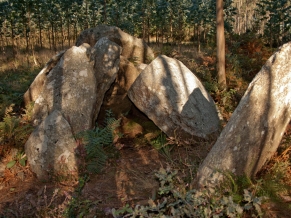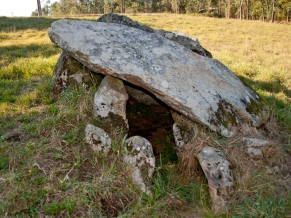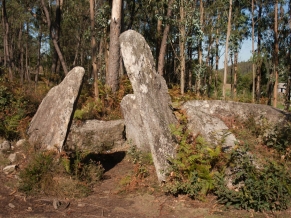- Home
- Experiences
- Places of interest
- The memory of rocks
The memory of rocks
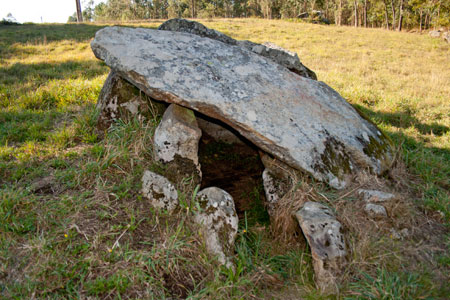
Costa da Morte is the area with the highest density of mámoas (tumuli) in Galicia, with more than 300 megalithic structures and some of the most important dolmens. In Terra de Soneira, and particularly the municipality of Vimianzo, these monuments abound. So much so that the region can be considered a megalithic archaeological site.
These dolmens and tumuli date from between 4.000 and 2.000 BC. and, according to existing studies, they were burial sites for people who lived in Terra de Soneira. Upon their death, their relatives deposited their remains under these constructions, usually composed of a flat stone supported by several flat standing stones, along with grave goods such as vessels, arrowheads and pottery.
There are in Vimianzo up to six megalithic sites, namely:
A Mina
Located about 4 miles from the Castle of Vimianzo, in the parish of Carantoña, is A Mina, a tumulus dating from 4.000 or 3.000 BC. We only see an earthen mound, with the dolmen hiding underneath. In 1936, it became the object of clandestine excavations by treasure hunters.
Pedra da Arca
In the parish of Baíñas (+43° 00' 36 "-9° 00' 52"), 11.5 miles from Vimianzo, there is one of the largest antas (dolmens) in Galicia, Pedra da Arca. It is part of a large tumulus measuring 92 feet wide and 98 feet long, with the capstone alone weighing 12 tons. Its walls still have traces of engravings consisting of U- and V-shaped lines, and red paint, very rare at the time.
Casota de Berdoias
Located in Berdoias (+43° 2' 52"-9° 5' 11"), about 5.5 miles from the town centre. According to a study by architect Emilio Fonseca Moretón, the dolmen’s tumular shape and lack of corridor are indicators that it is part of the predecessors of the cistas (individual megalithic funerary monuments) of the Bronze Age. It also has crosses and small cave-shapes engraved on its walls. Due to its structure and good condition it served for a long time as a shelter for the local shepherds.
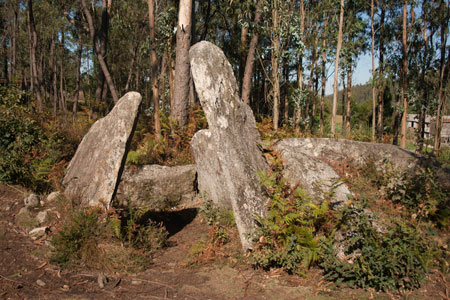
Pedra Cuberta
It is one of the Galician megalithic monuments we have more data about, thanks to the studies carried out by archaeologists German Georg and Vera Leisner in the 1930’s. Of special interest is its corridor, decorated with black and red drawings on a white background of snake-like lines and concentric circles. These paintings are among the most important to European megalithic art. It is located in the parish of Treos (43° 5' 48 ", -8° 58' 52"), 4.4 miles from Vimianzo.
Pedra da Lebre
Pedra da Lebre (43° 4' 5"-9° 00' 7") is located in the parish of Serramo, 5 miles from the Castle of Vimianzo. It is a large construction consisting of five upright stones, each more than 27 inches thick. The capstone is not in its original place anymore, and the remains of the corridor can still be seen lying about on the ground.
Pedra Moura
This dolmen is located in Serramo (43° 4' 53" -8° 58' 57"), in the middle of a tumulus almost completely destroyed on account of the agricultural work carried out in the area. It measures 13.5 feet by 8 feet and the chamber consists of seven upright stones, retaining only three small pillars. The capstone is out of place.
